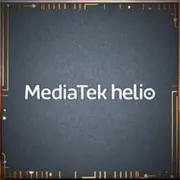MediaTek Helio G90

MediaTek Helio G90: Review of the Processor for Smartphones in 2025
April 2025
Introduction: Who Needs Helio G90 in 2025?
The MediaTek Helio G90 is a System-on-Chip (SoC) released in 2019, yet it remains in demand in the budget segment. Despite its age, this processor continues to be featured in new smartphones priced between $200 and $300, offering a balance between performance and price. In 2025, it finds its niche among users who do not require 5G support but value stable gaming and multimedia performance. Let’s explore the advantages and limitations of the Helio G90 today.
1. Architecture and Process Technology: The Basis of Performance
CPU: 8 Cores with Task Distribution
The Helio G90 is built on a hybrid architecture of ARM Cortex-A76 and Cortex-A55:
- 2 high-performance Cortex-A76 cores clocked up to 2.05 GHz for heavy tasks (gaming, video rendering).
- 6 energy-efficient Cortex-A55 cores clocked up to 2.0 GHz for background processes and battery savings.
This division allows for optimized energy consumption without sacrificing speed in everyday scenarios.
GPU: Mali-G76 MP4
The Mali-G76 MP4 GPU with four computing units supports gaming at medium settings. It is compatible with Vulkan and OpenGL ES 3.2 APIs, which are essential for modern mobile games. However, in 2025, its capabilities are limited: in titles like Genshin Impact, one will have to lower the quality to Medium at 30 FPS.
Process Technology: 12 nm — Pros and Cons
The 12-nanometer process technology of the Helio G90 falls short compared to modern 6–7 nm chips in energy efficiency. This results in slightly higher heating under load, but for undemanding users, the difference is not critical.
2. Performance: Gaming, Multimedia, and AI
Gaming: Moderate Capabilities
- PUBG Mobile: Stable 40–45 FPS on medium settings.
- Call of Duty: Mobile: 50–55 FPS in Multiplayer mode.
- Honkai: Star Rail: Medium/30 FPS with occasional dips.
For smooth gaming, effective heat dissipation is crucial. In smartphones with passive cooling (e.g., Xiaomi Redmi Note 10 Pro), throttling can occur after 20–30 minutes of play.
Multimedia and AI
- Supports displays up to 90 Hz (dependent on device model).
- MediaTek's APU 2.0 AI accelerator enhances camera performance: HDR scenarios, object recognition, portrait mode.
- Video encoding: 4K/30 FPS (H.265) — sufficient for casual filming.
Power Consumption
With a TDP of 5W and a 5000 mAh battery, a smartphone with Helio G90 operates for 6–8 hours in active use. In standby mode, it can last up to 2 days.
3. Built-in Modules: Connectivity and Communications
- 4G LTE Cat-12 Modem: Download speeds of up to 600 Mbps. The lack of 5G is a major downside in 2025, but it is not an issue for regions with poor 5G coverage.
- Wi-Fi 5 (802.11ac) and Bluetooth 5.0: Supports Dual-Band Wi-Fi but lacks Wi-Fi 6. It suffices for home use, but public networks may cause lag.
- Navigation: GPS, GLONASS, Galileo — rapid location identification even in difficult conditions.
4. Comparison with Competitors
MediaTek Helio G90 vs Qualcomm Snapdragon 778G (2021)
- The Snapdragon 778G (6 nm) excels in energy efficiency and supports 5G. In AnTuTu 10 tests, it scores around 550,000 points compared to Helio G90's 372,680.
- However, smartphones with Snapdragon 778G start at $350, while those with Helio G90 begin at $200.
MediaTek Helio G90 vs MediaTek Dimensity 700 (2021)
- The Dimensity 700 (7 nm) features a 5G modem and a more modern Mali-G57 MC2 GPU. However, in gaming, Helio G90 demonstrates better stability due to optimization.
5. Use Cases
Gaming
Suitable for casual games (Candy Crush, Among Us) and medium settings in AAA titles. It is ideal for teenagers or users not willing to pay for flagship devices.
Everyday Tasks
- Smooth operation in social media, browsers, streaming (Netflix, YouTube).
- Multitasking: simultaneously running 5–7 applications (with 6–8 GB of RAM).
Photo and Video
- Supports cameras up to 64 MP. In devices from 2025, Sony IMX682 or Samsung ISOCELL GW1 sensors are commonly used.
- Night mode and HDR operate quickly, but quality lags behind flagships.
6. Pros and Cons
Advantages
- Affordable device prices.
- Good optimization for gaming.
- Stable performance in basic scenarios.
Disadvantages
- No 5G support.
- Outdated 12 nm process technology.
- Limitations in video recording (no 4K/60 FPS).
7. Tips for Choosing a Smartphone with Helio G90
1. Cooling: Look for models with copper pipes or graphite coatings (e.g., Poco X4 NFC).
2. RAM: At least 6 GB for gaming.
3. Display: AMOLED with 90 Hz will enhance the experience (Realme 8 Pro).
4. Battery: 5000 mAh compensates for the power consumption of the 12 nm chip.
Popular Devices in 2025
- Xiaomi Redmi Note 12E: $220, 6/128 GB, 90 Hz AMOLED.
- Realme C55 HyperCharge: $250, 8/256 GB, 33W charging.
8. Final Conclusion: Who is the Helio G90 For?
This processor is an option for those who:
- Are looking for a smartphone under $300.
- Do not need 5G and play at medium settings.
- Value battery life and reliability.
Key Benefits: Savings of up to $150 compared to 5G counterparts, sufficient performance for 80% of users.
The Helio G90 proves that even outdated chips can remain relevant if manufacturers prioritize correctly. In 2025, it is a prudent choice for a first smartphone or a backup device.
Basic
6x 2 GHz – Cortex-A55
GPU Specifications
Connectivity
Memory Specifications
Miscellaneous
Benchmarks
Compared to Other SoC
Share in social media
Or Link To Us
<a href="https://cputronic.com/soc/mediatek-helio-g90" target="_blank">MediaTek Helio G90</a>